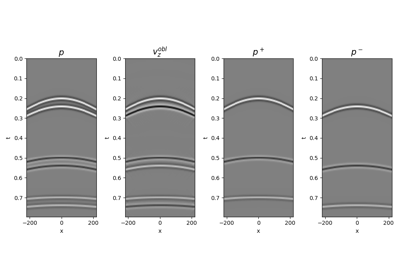pylops.waveeqprocessing.UpDownComposition2D¶
- pylops.waveeqprocessing.UpDownComposition2D(nt, nr, dt, dr, rho, vel, nffts=(None, None), critical=100.0, ntaper=10, scaling=1.0, backend='numpy', dtype='complex128', name='U')[source]¶
2D Up-down wavefield composition.
Apply multi-component seismic wavefield composition from its up- and down-going constituents. The input model required by the operator should be created by flattening the separated wavefields of size \(\lbrack n_r \times n_t \rbrack\) concatenated along the spatial axis.
Similarly, the data is also a flattened concatenation of pressure and vertical particle velocity wavefields.
- Parameters
- nt
int Number of samples along the time axis
- nr
int Number of samples along the receiver axis
- dt
float Sampling along the time axis
- dr
float Sampling along the receiver array
- rho
float Density \(\rho\) along the receiver array (must be constant)
- vel
float Velocity \(c\) along the receiver array (must be constant)
- nffts
tuple, optional Number of samples along the wavenumber and frequency axes
- critical
float, optional Percentage of angles to retain in obliquity factor. For example, if
critical=100only angles below the critical angle \(|k_x| < \frac{f(k_x)}{c}\) will be retained will be retained- ntaper
float, optional Number of samples of taper applied to obliquity factor around critical angle
- scaling
float, optional Scaling to apply to the operator (see Notes for more details)
- backend
str, optional Backend used for creation of obliquity factor operator (
numpyorcupy)- dtype
str, optional Type of elements in input array.
- name
str, optional New in version 2.0.0.
Name of operator (to be used by
pylops.utils.describe.describe)
- nt
- Returns
- UDop
pylops.LinearOperator Up-down wavefield composition operator
- UDop
See also
UpDownComposition3D3D Wavefield composition
WavefieldDecompositionWavefield decomposition
Notes
Multi-component seismic data \(p(x, t)\) and \(v_z(x, t)\) can be synthesized in the frequency-wavenumber domain as the superposition of the up- and downgoing constituents of the pressure wavefield (\(p^-(x, t)\) and \(p^+(x, t)\)) as follows [1]:
\[\begin{split}\begin{bmatrix} \hat{p} \\ \hat{v_z} \end{bmatrix}(k_x, \omega) = \begin{bmatrix} 1 & 1 \\ \frac{k_z}{\omega \rho} & - \frac{k_z}{\omega \rho} \\ \end{bmatrix} \begin{bmatrix} \hat{p^+} \\ \hat{p^-} \end{bmatrix}(k_x, \omega)\end{split}\]where the vertical wavenumber \(k_z\) is defined as \(k_z=\sqrt{\frac{\omega^2}{c^2} - k_x^2}\).
We can write the entire composition process in a compact matrix-vector notation as follows:
\[\begin{split}\begin{bmatrix} \mathbf{p} \\ s\mathbf{v_z} \end{bmatrix} = \begin{bmatrix} \mathbf{F} & 0 \\ 0 & s\mathbf{F} \end{bmatrix} \begin{bmatrix} \mathbf{I} & \mathbf{I} \\ \mathbf{W}^+ & \mathbf{W}^- \end{bmatrix} \begin{bmatrix} \mathbf{F}^H & 0 \\ 0 & \mathbf{F}^H \end{bmatrix} \mathbf{p^{\pm}}\end{split}\]where \(\mathbf{F}\) is the 2-dimensional FFT (
pylops.signalprocessing.FFT2), \(\mathbf{W}^\pm\) are weighting matrices which contain the scalings \(\pm \frac{k_z}{\omega \rho}\) implemented viapylops.basicprocessing.Diagonal, and \(s\) is a scaling factor that is applied to both the particle velocity data and to the operator has shown above. Such a scaling is required to balance out the different dynamic range of pressure and particle velocity when solving the wavefield separation problem as an inverse problem.As the operator is effectively obtained by chaining basic PyLops operators the adjoint is automatically implemented for this operator.
- 1
Wapenaar, K. “Reciprocity properties of one-way propagators”, Geophysics, vol. 63, pp. 1795-1798. 1998.
